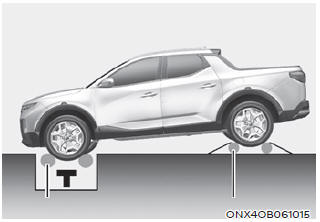Hyundai Santa Cruz: All Wheel Drive (AWD) / Emergency Precautions
Tires
Do not use tire and wheel with different size and type from the one originally installed on your vehicle. It can affect the safety and performance of your vehicle, which could lead to steering failure or rollover causing serious injury.
When replacing the tires, be sure to equip all four tires with the tire and wheel of the same size, type, tread, brand and load-carrying capacity. If you equip your vehicle with any tire/wheel combination not recommended by HYUNDAI for offroad driving, you should not use these tires for highway driving.
WARNING
Never start or run the engine while a full-time AWD vehicle is raised on a jack. The vehicle can slip or roll off of a jack causing serious injury or death to you or those nearby.
Towing
AWD vehicles must be towed with a wheel lift and dollies or flatbed equipment with all the wheels off the ground. For more details, refer to "Towing" in chapter 8.
Dynamometer testing
A full-time AWD vehicle must be tested on a special four wheel chassis dynamometer.

A full-time AWD vehicle should not be tested on a 2WD roll tester. If a 2WD roll tester must be used, perform the following procedure:
1. Check the tire pressures
recommended for your vehicle.
2. Place the front wheels on the roll
tester for a speedometer test as
shown in the illustration.
3. Release the parking brake.
4. Place the rear wheels on the
temporary free roller as shown in the
illustration.
CAUTION
- Never engage the parking brake while performing the test.
- When the vehicle is lifted up, do not operate the front and rear wheel separately. All four wheels should be operated.
WARNING
Keep away from the front of the vehicle while the vehicle is in gear on the dynamometer. The vehicle can jump forward and cause serious injury or death.
 AWD Operation
AWD Operation
Four Wheel Drive (AWD) mode selection
WARNING
If AWD warning light () stays
on
the instrument cluster, your vehicle
may have a malfunction with the
AWD system. When the AWD warning
light () illu ...
 Special Driving Conditions
Special Driving Conditions
Hazardous Driving Conditions
When hazardous driving elements
are encountered such as water, snow,
ice, mud and sand, take the following
precautions:
Drive cautiously and maintain a longer
braki ...
Other information:
Hyundai Santa Cruz (NX4A OB) 2021-2025 Service Manual: Outside Rear View Mirror
- Component Location
1. Outside rear view mirror
- Replacement
• When removing with a flat-tip screwdriver or remover, wrap protective tape around the tools to prevent damage to components.
• Put on gloves to prevent hand injuries.
1.Remove the front door ...
Hyundai Santa Cruz 2021-2025 Owners Manual: Intelligent speed limit assist (ISLA)
Intelligent Speed Limit Assist uses
information from the speed limit signs
along the roadway as well as speed limit
information in the navigation system to
inform the driver and display the speed
limit information in the LCD cluster.
On some models, the system works with
Smart Cruise Control a ...
